 |
| Gouncourts: Germinie Lacerteux (1864) explores the lurid life of a domestic servant. |
In music -- unlike painting and literature -- the period 1815-1900 is generally associated with Romanticism. Bizet's Carmen is one of the works that challenges that blanket labeling of so long and complex a period ... A cigarette factory's lunch bell rings, disgorging female workers into the sunlight, who stream over a bridge, all smoking, into the town square (Act I Scene 1). The two lead characters are a girl of low morals (Carmen) and an army deserter (Don José), who associate with an unruly band of smugglers, one killing the other center-stage in the final scene. This subject matter contains classic elements of the 19th-century Realist movement.
1. Realism in Painting & Literature
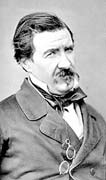 |
| Champfleury (=J.-F.-F. Husson) |
Realism established itself as an anti-Romantic reaction in French painting and literature around the mid-19th century. Its manifesto was the book Realism (1857) by novelist and theoretician Champfleury (1821-89), who claimed that novels should be "daguerreotypes" [an early form of photography invented in the 1830s] of everyday life. Fellow realist Duranty wrote: "Realism's work is finished when an exact, complete, honest reproduction has been achieved of the social milieu at the time in which the artist lives."
Most influential on Champfleury's theory was the painter Gustave Courbet (1819-77), whose The Stone-Breakers (1849), the first of a series of powerfully realistic paintings, is emblematic of visual realism, and shocked its viewers when exhibited in 1850-51 with its frank, unglamorized portrayal of two peasant laborers:
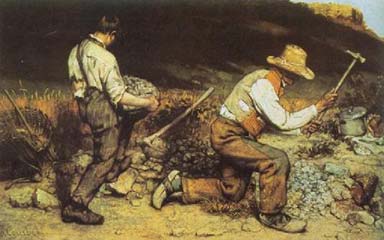 |
| Courbet: Stone-Breakers (1849) |
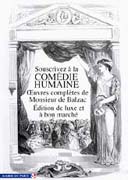
In literature, the first writer to provide a comparable unglamorized study of humankind was Honoré de Balzac (1799-1850), whose series of nearly 90 novels, The Human Comedy (1829-47), objectively portrayed men and women (over 2,000 of them) in all walks of life.
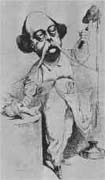 |
| caricature: Flaubert "dissecting" Madame Bovary |
Madame Bovary (1857), by Gustave Flaubert (1821-80), was, however, the novel that consolidated the literary realist movement, with its unremitting portrait of middle-class life and attitudes. Other exponents were the brothers Gouncourt, whose series of novels in the 1860s each examined a particular milieu in harsh detail, Stendhal, Zola, and outside France, Dickens, Trollope, Eliot, Turgenev, and Dostoyevsky.
2. Realism in Mérimée's novella
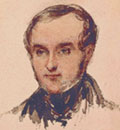 |
| Mérimée |
Prosper Mérimée's novella Carmen was first published in the magazine Revue des deux mondes (to which Balzac was a regular contributor) in 1845, its second edition, with an additional chapter, in 1847. It is thus an early example of realism using, alongside elements of exoticism and mystery, precisely detailed description, as in the fight between Don José and Carmen's gypsy "husband" Garcia (not featured in the opera):
He held his hat in his left hand, to parry my thrusts, and his knife in front of him, in the Andalusian mode of defense. I took up the Navarrese stance, facing him head-on, with my left arm raised, my left leg forward, and my knife against my right thigh. I felt stronger than a giant. He flew at me like a dart. I turned on my left foot, and he encountered empty air; but my knife found his throat, and went in so deep that my hand met his chin. I turned the blade so hard that it broke. It was over. A gush of blood as thick as my arm forced the blade out of the wound. He fell on his face as stiff as a post.
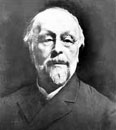 |
| Taine |
Mérimée's Carmen is also an early example of naturalism in literature -- a movement directly inspired by contemporary scientific developments, its principal theorist being Hippolyte Taine (1828-93). Mérimée's narrator is an archaeologist and comparative linguist investigating Caesar's Spanish wars with a view to an eventual scholarly article. He supplies his tale with learned footnotes, and there is a detached, quasi-scientific manner to much of the writing (see Mérimée's novella).
3. Realism in Bizet's Carmen
In preparing the opera (1873-5), Carmen's librettists dismantled Mérimée's narrative frame, but retained its modern-day realist setting -- cigarette factory, smuggling, bullfighting -- and subject matter: the misfortunes of working-class people (a factory worker; a corporal in the town guard, etc.). If anything, they intensified Carmen's low moral character and "outcast" status as a gypsy by inventing a wholly virtuous foil to her, Micaëla; and while removing Don José's "outcast" status as a Basque, they retained his and Carmen's capacity for hot-tempered action and physical violence.
The opera's musical realism comes not from descriptive devices such as those used by Berlioz in his Fantastic Symphony (musical mimicking of decapitation, witches' farts, etc.), nor from realistic use of music style: in the Habañera (see Selection 1) in Act I, for example, Bizet did use what he took to be (but turns out not to have been) a Spanish folksong to simulate Spanish music, however Bizet never visited Spain and made no claim to employ genuine Spanish and gypsy styles.
Carmen's musical realism lies more in the relation of music to character. Take the final Act IV duet (see Selection 2): Carmen and Don José never sing together in unison or parallel, as is typical at the end of a Romantic duet, signifying unity of sentiment. In the two "duet" sections, Carmen unconventionally answers Don José with a different vocal line (his more melodic and repeating, hers freer and always changing), and leads the music into quite different keys, thereby skillfully delineating their characters. The rest of the duet is conducted in a half-melodic recitative (reminiscent of Wagner's mature vocal lines) that conveys turbulent emotions. The close of the scene realistically portrays the conflicting feelings of the two characters, set in ironic relief by the incongruously jubilant shouts from the bullring backstage and the baleful "fate" motive injected by the orchestra.
FURTHER READING
Dahlhaus, Carl: Realism in Nineteenth-Century Music, trans. M. Whittall (Cambridge: Cambridge University Press, 1985), chapter 10 "The Musical Novel"
Encyclopaedia Britannica: "Courbet, Gustave," "Flaubert, Gustave," "Mérimée, Prosper," "Realism," "Naturalism"
The New Grove Dictionary of Music and Musicians, 2nd edn (2001): "Bizet, Georges"
